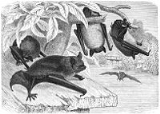
Daubenton's bat
Encyclopedia
Daubenton's Bat, Myotis daubentonii, is a Eurasia
n bat
with quite short ears. It ranges from Britain
to Japan
and is considered to be increasing its numbers in many areas.
The name commemorates the French naturalist Louis-Jean-Marie Daubenton
.
Daubenton's Bat is typically 45 to 55 mm long, with an average wingspan of 240 to 275 mm. Daubenton's Bat weighs between 7 and 15 grams.
Summer colonies are formed in underground caves, tunnels, cellars, mines, and underneath bridges. These colonies are also always near water. Daubenton's Bat also hibernates in the same type of locations from September to late March or April.
to find prey and orientate itself at night. Bats emit sounds too high in frequency for humans to detect and interpret the echoes created to build a "sound picture" of their surroundings. Daubenton's Bat emits echolocation calls of frequencies between 32 and 85 kHz, though typical calls peak at 45 to 50 kHz and have a duration of 3.3 ms.
The bats emerge at twilight to hunt for insects over the water. Their main diet consists of small flies, midges, mayflies, and moths. Daubenton's Bat often eats its prey while still in flight. A seven gram Daubenton's Bat often returns weighing 11 grams after a one hour feeding, increasing its body weight by 57%.
Daubenton's Bat is an endangered species in Germany and Austria.
Eurasia
Eurasia is a continent or supercontinent comprising the traditional continents of Europe and Asia ; covering about 52,990,000 km2 or about 10.6% of the Earth's surface located primarily in the eastern and northern hemispheres...
n bat
Bat
Bats are mammals of the order Chiroptera "hand" and pteron "wing") whose forelimbs form webbed wings, making them the only mammals naturally capable of true and sustained flight. By contrast, other mammals said to fly, such as flying squirrels, gliding possums, and colugos, glide rather than fly,...
with quite short ears. It ranges from Britain
Great Britain
Great Britain or Britain is an island situated to the northwest of Continental Europe. It is the ninth largest island in the world, and the largest European island, as well as the largest of the British Isles...
to Japan
Japan
Japan is an island nation in East Asia. Located in the Pacific Ocean, it lies to the east of the Sea of Japan, China, North Korea, South Korea and Russia, stretching from the Sea of Okhotsk in the north to the East China Sea and Taiwan in the south...
and is considered to be increasing its numbers in many areas.
The name commemorates the French naturalist Louis-Jean-Marie Daubenton
Louis-Jean-Marie Daubenton
Louis-Jean-Marie Daubenton was a French naturalist.Daubenton was born at Montbard . His father, Jean Daubenton, a notary, intended him for the church, and sent him to Paris to study theology, but Louis-Jean-Marie was more interested in medicine...
.
Description
Daubenton's Bat is a medium sized to small species. The bat's fluffy fur is brownish grey on the back and silvery grey on the underside. Juveniles have darker fur than adults. The bats have reddish pink faces and noses, but the area around the eyes is bare. When the bat is agitated, the ears are held at right angles. The wings and tail membrane are dark brown.Daubenton's Bat is typically 45 to 55 mm long, with an average wingspan of 240 to 275 mm. Daubenton's Bat weighs between 7 and 15 grams.
Habitat
The Daubenton's Bat is found throughout Britain, Europe, and as far as Japan and Korea. The bat is mostly found in woodlands and always chooses roosts close to water sources such as rivers or canals.Summer colonies are formed in underground caves, tunnels, cellars, mines, and underneath bridges. These colonies are also always near water. Daubenton's Bat also hibernates in the same type of locations from September to late March or April.
Hunting and diet
Daubenton's Bat is insectivorous and uses echolocationAnimal echolocation
Echolocation, also called biosonar, is the biological sonar used by several kinds of animals.Echolocating animals emit calls out to the environment and listen to the echoes of those calls that return from various objects near them. They use these echoes to locate and identify the objects...
to find prey and orientate itself at night. Bats emit sounds too high in frequency for humans to detect and interpret the echoes created to build a "sound picture" of their surroundings. Daubenton's Bat emits echolocation calls of frequencies between 32 and 85 kHz, though typical calls peak at 45 to 50 kHz and have a duration of 3.3 ms.
The bats emerge at twilight to hunt for insects over the water. Their main diet consists of small flies, midges, mayflies, and moths. Daubenton's Bat often eats its prey while still in flight. A seven gram Daubenton's Bat often returns weighing 11 grams after a one hour feeding, increasing its body weight by 57%.
Breeding
Mating occurs in autumn and fertilisation takes place the following spring. Females gather in maternity colonies of 40 to 80 bats during June and July. Daubenton's Bat is able to fly three weeks after birth and reaches independence at 6 to 8 weeks of age.Conservation
All bats in Britain are protected under Schedule 5 of the Wildlife and Countryside Act of 1981. The bats are also protected by the Conservation Regulations of 1994.Daubenton's Bat is an endangered species in Germany and Austria.
External links
- Population map, call sound bites
- ARKive Photographs, videos.
- http://www.bbc.co.uk/nature/wildfacts/factfiles/286.shtml information

